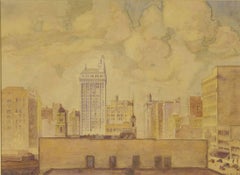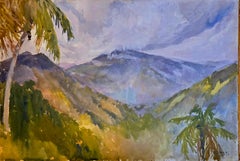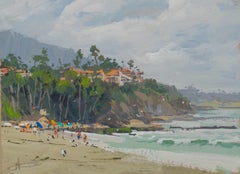Albert Tupel Art
to
1
Overall Width
to
Overall Height
to
1
1
1
1
1
1
1
1
9,478
2,688
1,375
1,361
1
Artist: Albert Tupel
"Dallas Skyline from the City Hall"
By Albert Tupel
Located in San Antonio, TX
Albert Tupel Dallas Artist Image Size: 13 x 17 3/4 Frame Size: 22 x 26 Medium: Watercolor Circa 1930s "Dallas Skyline from the City Hall"
Category
1930s Impressionist Albert Tupel Art
Materials
Watercolor
Related Items
Looking West from Richmond Hill, Port Antonio, Jamaica
By Philip Little
Located in North Clarendon, VT
Fantastic Philip Little watercolor of Jamaica from 1922. Watercolor paper mounted on board, signed and dated lower right.
Philip Little was a prominent Salem, Massachusetts, artist ...
Category
1920s American Impressionist Albert Tupel Art
Materials
Watercolor
"Treasure Island Beach, " Gouache painting
By Judd Mercer
Located in Denver, CO
Judd Mercer's (US based) "Treasure Island Beach," is an original, handmade oil painting that depicts blue waves crashing on the shore of a sandy beach filled with people.
About the Artist:
Judd Mercer is a watercolor painter based in Denver, Colorado. After attending art school for industrial design, Judd pursued a career in digital design and user experience and is co-owner of Elevated Third, a Denver-based digital agency.
After committing to writing and illustrating a full-length fantasy novel in his spare time, Judd began watercolor painting around 2014, studying with teachers such as Alvaro Castagnet, Joseph Zbukvic and Herman Pekel...
Category
2010s American Impressionist Albert Tupel Art
Materials
Gouache
"Spring Magic" Gouache Painting
By Judd Mercer
Located in Denver, CO
Judd Mercer's (US based) "Spring Magic" is an gouache painting that depicts the tilted landscape of a hill covered with trees and young saplings all dusted with the snow of a past wi...
Category
2010s Impressionist Albert Tupel Art
Materials
Gouache
"Feeding Time" Gouache Painting
By Judd Mercer
Located in Denver, CO
Judd Mercer's (US based) "Feeding Time" is an gouache painting that depicts a lone cow feeding in a small fenced pasture, framed with a white barn and towering trees
Bio/artist stat...
Category
2010s Impressionist Albert Tupel Art
Materials
Gouache
"Retirement" Gouache Painting
By Judd Mercer
Located in Denver, CO
Judd Mercer's (US based) "Retirement" is an gouache painting that depicts a rusted old tow truck among other cars in a lonely junkyard car lot
Bio/artist ...
Category
2010s Impressionist Albert Tupel Art
Materials
Gouache
"A Path Through the Wood" Gouache Painting
By Judd Mercer
Located in Denver, CO
Judd Mercer's (US based) "A Path Through the Wood" is an gouache painting that depicts the dense brush and thicket of the trees growing densely together
Bio/artist statement:
Judd...
Category
2010s Impressionist Albert Tupel Art
Materials
Gouache
"In the Canyon" Gouache Painting
By Judd Mercer
Located in Denver, CO
Judd Mercer's (US based) "In the Canyon" is an gouache painting that depicts a grouping of pine trees nestled at the base of a large green mountain with large fluffy clouds overhead
...
Category
2010s Impressionist Albert Tupel Art
Materials
Gouache
"Beach Day" Gouache Painting
By Judd Mercer
Located in Denver, CO
Judd Mercer's (US based) "Beach Day" is an gouache painting that depicts the calm inlet full of water and watersports, lined with trees and vegetation
Bio/artist statement:
Judd Me...
Category
2010s Impressionist Albert Tupel Art
Materials
Gouache
Vintage french art by Paul Emile Lecomte - Provence - oil signed on carton.
By Paul Emile Lecomte
Located in PARIS, FR
Provenance fron the Family Atelier of the artist. Framing options* available.
* Frame at an additional charge
Free US CONTINENTAL Shipping, incl Europe and Asia.
Born in Paris, the ...
Category
Late 19th Century Impressionist Albert Tupel Art
Materials
Watercolor, Pencil, Tempera
$1,347
H 18.9 in W 24.81 in
An abstract construct
By Haroutune Armenian
Located in La Canada Flintridge, CA
An abstract construct 2018 19x20 in . unframed (we'll frame upon customer request).
Very colorful composition.
His artwork has been published in two books “colors and Words: From Armenian and Beyond” and “Past Does Not yet Melt here”, the latter was the result of a journey to the result of a journey to the top of Mount Ararat...
Category
2010s Impressionist Albert Tupel Art
Materials
Watercolor
"Foothills Reserve" Gouache Painting
By Judd Mercer
Located in Denver, CO
Judd Mercer's (US based) "Foothills Reserve" is an gouache painting that depicts the rolling hills of the mountains with industrial construction materials seeming to interject on the...
Category
2010s Impressionist Albert Tupel Art
Materials
Gouache
Ararat valley
Located in La Canada Flintridge, CA
This watercolor painting features the majestic Mount Ararat, viewed from the valley where the artist resided. It exemplifies the distinctive style of Martiros Saryan, showcasing his ...
Category
1940s Impressionist Albert Tupel Art
Materials
Watercolor
Albert Tupel art for sale on 1stDibs.
Find a wide variety of authentic Albert Tupel art available for sale on 1stDibs. You can also browse by medium to find art by Albert Tupel in paint, watercolor and more. Much of the original work by this artist or collective was created during the 1930s and is mostly associated with the Impressionist style. Not every interior allows for large Albert Tupel art, so small editions measuring 26 inches across are available. Customers who are interested in this artist might also find the work of William Lemos, Irina Belotelkin Roublon, and Ralph Edward Joosten. Albert Tupel art prices can differ depending upon medium, time period and other attributes. On 1stDibs, the price for these items starts at $1,200 and tops out at $1,200, while the average work can sell for $1,200.


